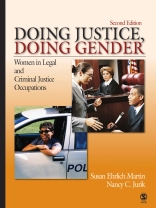‘Martin and Jurik provide a clear body of evidence illuminating the gendered nature of criminal justice occupations. Of the multitude of feminist works on this topic, this is one of the best analyses available.’
—
CRIMINAL JUSTICE REVIEW
Doing Justice, Doing Gender: Women in Legal and Criminal Justice Occupations is a highly readable, sociologically grounded analysis of women working in traditionally male dominant justice occupations of law, policing, and corrections. This
Second Edition represents not only a thorough update of research on women in these fields, but a careful reconsideration of changes in justice organizations and occupations and their impact on women′s justice work roles over the past 40 years.
New to the Second Edition:
- Introduces a wider range of workplace diversity and experiences: An expanded sociological theoretical framework grasps the interplay of gender, race, ethnicity, and sexual orientation in understanding workplace identities and inequities.
- Provides a better understanding of the centrality of gender issues to understanding the legal and criminal justice system in general: This edition further connects women′s work experiences to social trends and consequent changes in legal system and in criminal justice agencies.
- Offers a more international perspective: More material is included on women lawyers, police, and correctional officers in countries outside the U.S.
Intended Audience:
This is an excellent supplemental text for advanced undergraduate and graduate courses such as Gender & Work; Women and Work; Sociology of Work and Occupations; Women and the Criminal Justice System; and Gender Justice in the departments of Sociology, Criminal Justice, Women′s Studies, and Social Work.
قائمة المحتويات
List of Tables
Acknowledgments
1. Introduction: Changes in Criminal Justice, Occupations, and Women in the Workplace
The CJS: Mission, Processes, and Workforce
Historical Context of Women in Justice Occupations
Legal Changes
Systemic Reforms and Expanded Opportunities for Women
Women and Today′s Justice Occupations
Contents of the Second Edition of This Book
A Note on Perspective and Terminology
Endnotes
2. Explanations for Gender Inequality in the Workplace
Categorical Approaches to Gender Inequality at Work
Challenging Gender Dichotomies: Gender as Process
Our Approach: The Social Construction of Gender in the Workplace
Doing Gender in Work Organizations
Summary
Endnotes
3. The Nature of Police Work and Women′s Entry Into Law Enforcement
An Historical Overview: From Matron to Chief
The Increasing Representation of Women in Police Work
The Nature of Policing: Scope of Work and Occupational Culture
The Police Culture and Men′s Opposition to Women Officers
Barriers to Women Officers: Interaction, Ideology, and Images
Summary
Endnotes
4. Women Officers Encountering the Gendered Police Organization
Gendered Organizational Logic: Policies and Practices
Doing Gender on the Street: Dilemmas of Police-Citizen Encounters
Women′s Response: Adaptations, Costs, and Survival Strategies
Summary
Endnotes
5. Women Entering the Legal Profession: Change and Resistance
Historical Overview: Barriers to Women in Law Before 1970
Changing Laws and Job Queues: Opening Legal Practice to Women
Lawyers′ Jobs, Specialties, and the Division of Legal Labor
Gendered Legal Occupational Culture and Barriers to Women
Summary
Endnotes
6. The Organizational Logic of the Gendered Legal World and Women Lawyers′ Response
Gender Bias in Law School and Its Impact on the Learning Environment
Gender Bias in the Firm, Office, and Agency
The Impact of Gender Bias on Women Attorneys in Court and Beyond
Organizational Logic and Limiting Opportunity Structures
Women′s Responses to Gender Bias: Adaptation and Innovation
Summary
Endnotes
7. Women in Corrections: Advancement and Resistance
History of Women in Corrections: 1860s to 1960s
Social Change and Changing Queues for Women COs in the 1970s
Women′s Movement Into CO Jobs in Men′s Prisons: 1970s to Present
Characteristics of Women COs in Men′s Prisons
CO Jobs as a Resource for Doing Gender
Sites of Struggle: Gendered Interactions, Gendered Identities
Summary
8. Gendered Organizational Logic and Women CO Response
Gendered, Racialized, Sexualized, and Embodied Prison Organizations
Social Context and the Shifting Organizational Logic of Corrections
Prison Organizational Logic and Women′s Careers
Women′s Performance: Adaptation and Innovation
Summary
9. Doing Justice, Doing Gender Today and Tomorrow: Occupations, Organizations, and Change
Our Theoretical Approach: A Recap
Comparison of Opportunities, Barriers, and Women′s Responses
Do Women Make a Difference?
Building Feminist Theory and Policy
References
List of Cases Cited
Index
About the Authors
عن المؤلف
Nancy Jurik is a sociologist and professor in the School of Justice & Social Inquiry at Arizona State University. She has published research articles in the areas of gender and work, professionalization, changing workplace organizations, self-employment, and economic development programs. She has also published Bootstrap Dreams: U.S. Microenterprise Development in an Era of Welfare Reform (Cornell University Press, 2005).












